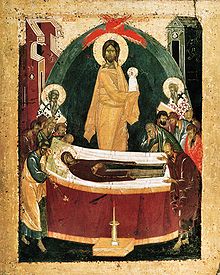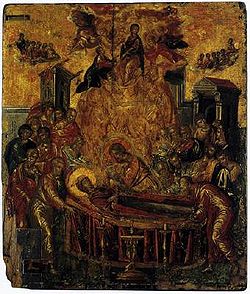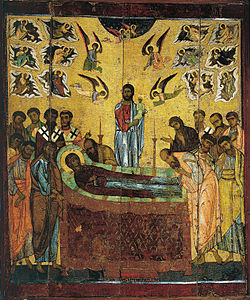- Dormition of the Theotokos
-
"Dormition of the Virgin" redirects here. For the El Greco painting of the same name, see Dormition of the Virgin (El Greco).
The Dormition of the Theotokos (Greek: Κοίμησις Θεοτόκου, Koímēsis, often anglicized as Kimisis) is a Great Feast of the Eastern Orthodox, Oriental Orthodox and Eastern Catholic Churches which commemorates the "falling asleep" or death of the Theotokos (Mary, the mother of Jesus; literally translated as God-bearer), and her bodily resurrection before being taken up into heaven. It is celebrated on August 15 (August 28, N.S. for those following the Julian Calendar) as the Feast of the Dormition of the Mother of God. The Armenian Apostolic Church celebrates the Dormition not on a fixed date, but on the Sunday nearest August 15.
Contents
Dormition fast
Liturgical year Western - Advent
- Christmastide
- Epiphany
- Pre-Lent
- Lent
- Easter Triduum
- Eastertide
- Ascensiontide
- Pentecost
- Ordinary Time
Eastern - Feast of Cross
- Nativity Fast
- Nativity
- Theophany
- Great Lent
- Pascha
- Pentecost
- Apostles' Fast
- Great Feasts
- Transfiguration
- Dormition
- Protection
The Feast of the Dormition is preceded by a two-week fast, referred to as the Dormition Fast. From August 1 to August 14 (inclusive) Orthodox and Eastern Catholics fast from red meat, poultry, meat products, dairy products (eggs and milk products), fish, oil, and wine. The Dormition Fast is a stricter fast than either the Nativity Fast (Advent) or the Apostles' Fast, with only wine and oil (but no fish) allowed on weekends. As with the other Fasts of the Church year, there is a Great Feast that falls during the Fast; in this case, the Transfiguration (August 6), on which fish, wine and oil are allowed.
In some places, the services on weekdays during the Fast are similar to the services during Great Lent (with some variations). Many churches and monasteries in the Russian tradition will perform the Lenten services on at least the first day of the Dormition Fast. During the Fast, either the Great Paraklesis (Supplicatory Canon) or the Small Paraklesis are celebrated every evening except Saturday evening and the Eves of the Transfiguration and the Dormition.[1]
The first day of the Dormition Fast is a feast day called the Procession of the Cross (August 1), on which day it is customary to have a crucession and perform the Lesser Sanctification of Water.
Significance of the feast
In Orthodoxy and Catholicism, as in the language of scripture, death is often called a "sleeping" or "falling asleep" (Greek κοίμησις; whence κοιμητήριον > coemetērium > cemetery, a place of sleeping). A prominent example of this is the name of this feast; another is the Dormition of Anna, Mary's mother. According to Orthodox and Eastern Catholic tradition Mary, having spent her life after Pentecost supporting and serving the nascent Church, was living in the house of the Apostle John, in Jerusalem, when the Archangel Gabriel revealed to her that her repose would occur three days later. The apostles, scattered throughout the world, are said to have been miraculously transported to be at her side when she died. The sole exception was Thomas, who had been delayed. He is said to have arrived three days after her death in a cloud above her tomb is said to have seen her body leaving to heaven, he asked her "Where are you going, O Holy One?" and then she took off her girdle and gave it to him and said "Receive this my friend" then she disappeared.[2] Thomas was taken to his fellow Apostles and asked to see her grave so that he could bid her goodbye. Mary had been buried in Gethsemane, according to her request. When they arrived at the grave, her body was gone, leaving a sweet fragrance. An apparition is said to have confirmed that Christ had taken her body to heaven after three days to be reunited with her soul. Orthodox theology teaches that the Theotokos has already undergone the bodily resurrection which all will experience at the Second coming, and stands in heaven in that glorified state which the other righteous ones will only enjoy after the Last Judgment.[3]
Dormition versus Assumption
The Dormition: ivory plaque, late 10th-early 11th century (Musée de Cluny).
The Dormition of the Theotokos is celebrated on August 15 (August 28, N.S. for those following the Julian Calendar), the same calendar day as the Roman Catholic Feast of the Assumption of Mary. The Dormition and the Assumption are different names for the same event, Mary's departure from the earth, although the beliefs are not entirely the same.
The Orthodox Church teaches that Mary died a natural death, like any human being; that her soul was received by Christ upon death; and that her body was resurrected on the third day after her repose, at which time she was taken up, bodily only, into heaven. Her tomb was found empty on the third day.
Roman Catholic teaching holds that Mary was "assumed" into heaven in bodily form, just as her son Jesus ascended. Some Catholics agree with the Orthodox that this happened after Mary's death, while some hold that she did not experience death. Pope Pius XII, in his Apostolic constitution, Munificentissimus Deus (1950), which dogmatically defined the Assumption, left open the question of whether or not Mary actually underwent death in connection with her departure, but alludes to the fact of her death at least five times.
Both churches agree that she was taken up into heaven bodily. The Orthodox belief regarding Mary's falling asleep are expressed in the liturgical texts used of the feast of the Dormition (August 15) which is one of the Twelve Great Feasts of the Orthodox Church, and is held by all pious Orthodox Christians.
The Eastern Catholic observance of the feast corresponds to that of their Orthodox counterparts, whether Eastern Orthodox or Oriental Orthodox.
The Dormition is known as the Death of the Virgin in Catholic art, where it is a reasonably common subject, mostly drawing on Byzantine models, until the end of the Middle Ages. The Death of the Virgin by Caravaggio, of 1606, is probably the last famous Western painting of the subject.
Liturgical practices
It is customary in many places to bless fragrant herbage on the Feast of the Dormition.
In some places, the Rite of the "Burial of the Theotokos" is celebrated at the Dormition, during the All-Night Vigil. The order of the service is based on the service of the Burial of Christ on Great Saturday. An Epitaphios of the Theotokos, a richly embroidered cloth icon portraying her lying in state is used, together with specially composed hymns of lamentation which are sung with Psalm 118. There are also special Evlogitaria of the Dormition which are chanted, echoling the Evlogitaria of the Resurrection which are chanted on Great Saturday and at Sunday Matins throughout the year. The Epitaphios is placed on a bier, and carried in procession in the same way as the Epitaphios of Christ is during Holy Week.
This practice began in Jerusalem, and from there it was carried to Russia, where it was followed in various Dormition Cathedrals, in particular that of Moscow. The practice slowly spread among the Russian Orthodox, though it is not by any means a standard service in all parishes, or even most cathedrals or monasteries. In Jerusalem, the service is chanted during the Vigil of the Dormition. In some Russian churches and monasteries, it is served on the third day after Dormition.
The Feast of the Dormition has a one-day Forefeast and 8 days of Afterfeast. The feast is framed and accentuated by three feasts in honour of Jesus Christ, known as the "Three Feasts of the Saviour in August". These are: the Procession of the Cross (August 1), the Transfiguration (August 6), and the Icon of Christ "Not Made by Hand" (August 16).
The Maronite Church has a tradition that their Third Anaphora of the Apostle Peter or Sharrar (the Maronite redaction of the Holy Qurbana of Addai and Mari) was originally composed for and used at the funeral of the Theotokos. This tradition probably developed because in its final form the anaphora has twelve paragraphs, i.e., one for each concelebrating apostle present at the funeral mass of the Theotokos
Development of the Dormition tradition
 Icon of the Dormition by Theophan the Greek, 1392. The Theotokos is depicted lying on a bier, surrounded by the Twelve Apostles. At center, Jesus Christ is shown in a mandorla, swadling the soul of the Virgin Mary (a red seraph is shown above his head). To either side of him are depicted the Hieromartyrs Dionysius the Areopagite and Ignatius the God-Bearer who, according to sacred tradition, are responsible for transmitting the account of the dormition.
Icon of the Dormition by Theophan the Greek, 1392. The Theotokos is depicted lying on a bier, surrounded by the Twelve Apostles. At center, Jesus Christ is shown in a mandorla, swadling the soul of the Virgin Mary (a red seraph is shown above his head). To either side of him are depicted the Hieromartyrs Dionysius the Areopagite and Ignatius the God-Bearer who, according to sacred tradition, are responsible for transmitting the account of the dormition.
The Dormition tradition is associated with various places, most notably with Jerusalem, which contains Mary's Tomb and the Basilica of the Dormition, and Ephesus, which contains the House of the Virgin Mary, and also with Constantinople[citation needed].
The first four Christian centuries are silent regarding the end of the Virgin Mary's life, though it is asserted, without surviving documentation, that the feast of the Dormition was being observed in Jerusalem shortly after the Council of Ephesus.[4]
At the point in the later fifth century when the earliest Dormition traditions surface in manuscripts, Stephen Shoemaker has detected[5] the sudden appearance of three distinct narrative traditions describing the end of Mary's life: he has characterised them as the "Palm of the Tree of Life" narratives, the "Bethlehem" narratives, and the "Coptic" narratives—aside from a handful of atypical narratives.
One might notice the similarities between the traditional depictions of the Dormition of the Theotokos in Byzantine iconography and the account of the death of the Egyptian Desert Father, Sisoes the Great.[6] In both Christ is seen coming to receive the soul of the dying saint surrounded by an aureola or cloud of blinding light and accompanied by the angels and prophets. In Byzantine iconography the other Christ is shown surrounded by such a cloud of light are those of also seen in icons of the Transfiguration, the Resurrection and the Last Judgment. One might further note that in some icons of the Dormition the Theotokos is depicted at the top of the icon in a similar aureola before the opening gates of heaven. This suggests that contemporary accounts of the deaths of the Desert Fathers accompanied by sudden burst of light came to influence the development of the iconography of the Dormition.
See also
- Assumption of Mary
- Assumption Cathedral – a number of Russian churches are dedicated to this feast
- Death of the Virgin – the same subject in Western art.
Notes
- ^ Outside the Dormition Fast it is always the Small Supplicatory Canon (Paraklesis) which is chanted. During the Dormition Fast, however, the Typikon prescribes that the Small and Great Supplicatory Canons be chanted on alternate evenings: If August 1st falls on a Monday through Friday, the cycle begins with the Small Supplicatory Canon; if August 1st falls on a Saturday or Sunday, the cycle begins with the Great Supplicatory Canon.
- ^ "Dormition (Keemeesis) of the Theotokos". The Life of the Virgin Mary, The Theotokos. Holy Apostles Convent and Dormition Skete. http://www.balamand.edu.lb/theology/feastdormition.htm. Retrieved 6 May 2011.
- ^ Ware, Archimandrite Kallistos; Mary, Mother (1984), The Festal Menaion, London: Faber and Faber, p. 64, ISBN 0-571-11137-8
- ^ A fairly representative example of mainstream Orthodox teaching is offered by Sophia Fotopoulou: "We have no historical data to indicate how long the Mother of God remained on earth after the ascension of Christ into heaven, nor when, where, or how she died, for the Gospels say nothing of this. The foundation for the feast of the Dormition is to be found in a sacred tradition of the Church dating from apostolic times, apocryphal writings, the constant faith of the People of God, and the unanimous opinion of the holy Fathers and Doctors of the Church of the first thousand years of Christianity." "The Dormition of the Theotokos".
- ^ Stephen J. Shoemaker, 2003. Ancient Traditions of the Virgin Mary's Dormition and Assumption (Oxford University Press).
- ^ http://www.stjohndc.org/Russian/saints/e_0107c.htm
Further reading
- Shoemaker, Stephen J (2002). Ancient traditions of the Virgin Mary's dormition and assumption. Oxford, New York: Oxford University Press. ISBN 9780199250752. OCLC 50101584.
External links
- Full liturgical and hymnographic texts and readings for the Feast of the Dormition of the Theotokos (in English)
- Service of the Burial / Lamentations of the Theotokos, forming part of the Feast of the Dormition (in English)
- The Dormition of our Most Holy Lady the Mother of God and Ever-Virgin Mary Orthodox icon and synaxarion
- Icons of the Feast of Dormition
- Icons of the Dormition
- Dormition article on Orthodox Wiki
- Epitaphios of the Theotokos Russia
- Celebrating Dormition in the Holy Land Jerusalem
- Translation of the Dormition Icon of the Mother of God from Constantinople to the Kiev Caves, Far Caves (Feast celebrated May 3)
Categories:- Catholic holy days
- Great Feasts of the Orthodox Church
- August observances
- Eastern Christian liturgy
- Eastern Orthodoxy
- Liturgical calendar
- Easter
- Christian behaviour and experience
- Oriental Orthodoxy
- Marian devotions
- Christian festivals and holy days
- Marian dogmas
Wikimedia Foundation. 2010.



